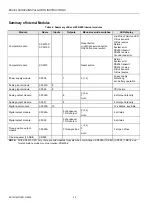
EXCEL 500/600 INSTALLATION INSTRUCTIONS
COMMUNICATIONS
L
ON
W
ORKS
Bus Wiring
Connection between the Distributed I/O modules and the
CPU are made from the L
ON
W
ORKS
connector module
XSL511. The L
ON
W
ORKS
bus is a 78-kilobit serial link that
uses transformer isolation so that the bus wiring does not
have a polarity; that is, it is not important which of the two
L
ON
W
ORKS
bus terminals are connected to each wire of the
twisted pair.
The L
ON
W
ORKS
bus can be wired in daisy chain, star, loop or
any combination thereof as long as the maximum wire length
requirements given below are met. The recommended
configuration is a daisy chain with two bus terminations. This
layout allows for maximum L
ON
W
ORKS
bus length, and its
simple structure presents the least number of possible
problems, particularly when adding on to an existing bus.
Table 16. Doubly-terminated bus specifications
Cable type
Max. bus length
Belden 85102
2700 m (8900 ft)
Belden 8471
2700 m (8900 ft)
Level IV, 22 AWG
1400 m (4600 ft)
JY (St) Y 2x2x0.8
900 m (3000 ft)
TIA568A Categ. 5 24AWG, twisted pair
900 m (3000 ft)
NOTES:
The cable types listed above are as recommended
by Echelon in their FTT-10A User Guide. The cable
recommended by Honeywell is the level IV, 22
AWG, solid core, nonshielded cable. Belden part
numbers are 9H2201504 (plenum) and 9D220150
IMPORTANT
Do not use different wire types or gauges on the
same L
ON
W
ORKS
network segment. The step
change in line impedance characteristics would
cause unpredictable reflections on the bus.
NOTE:
In the event that the limit on the total wire length is
exceeded, then FTT physical layer repeaters
(FTT 10A) can be added to interconnect segments
and increase the overall length by an amount equal
to the original specification for that cable type and
bus type for each repeater used. For example,
adding repeaters for a doubly-terminated bus using
JY (St) Y 2x2x0.8 cable increases the maximum
length 3000 ft (900 m) for each repeater.
On the Excel 500-XCL5010 controller, the L
ON
W
ORKS
bus
connections are located on the communication module as
shown in Fig. 78:
LON SERVICE BUTTON
POWER, GRN
LON SERVICE, RED
LEDs
C-BUS TxD, YEL
C-BUS RxD, YEL
RESERVED
C-BUS
TERMINATION
SWITCH
1 2 3
4 5 6
LON
C-BUS
(non-plenum).
BUS
IMPORTANT
A1 A2
NO
T
US
E
D
SH
IE
L
D
C + C
00
00
01
24
It is recommended that ferrules not be used to
terminate stranded wires to be inserted in the
Distributed I/O Terminal blocks spring-clamp
terminals.
The FTT specification includes two components that must be
met for proper system operation. The distance from each
transceiver to all other transceivers and to the termination
must not exceed the
maximum node-to-node distance
. If
multiple paths exists, the
maximum total wire length
is the
total amount of wire used.
Table 17. Free topology (singly-terminated) specifications
Cable type
Max. node-to-
node distance
Max. total wire
length
Belden 85102
1650 ft (500m)
1650 ft (500m)
Belden 8471
1300 ft (400m)
1650 ft (500m)
Level IV, 22AWG
1300 ft (400m)
1650 ft (500m)
JY (St) Y 2x2x0.8
1050 ft (320m)
1650 ft (500m)
TIA568A Category 5
24AWG, twisted pair
825 ft (250m)
1500 ft (450m)
Fig. 78. Excel 500-XCL5010 communication module
L
ON
W
ORKS
Bus Termination
Depending upon the configuration, either one or two
termination modules are required for terminating a L
ON
W
ORKS
bus with FTT devices on it. The following two different
L
ON
W
ORKS
termination units are available for this purpose:
•
209541B
L
ON
W
ORKS
Bus Termination Module (see Fig.
79 and Fig. 80) and
•
XAL-Term
L
ON
W
ORKS
connection and termination
module (see Fig. 81), which can be mounted on DIN rails
and in fuse boxes.
Fig. 79. Termination Module 209541B connections for
doubly-terminated FTT network
EN1R-1047GE51 RR0902
36













































